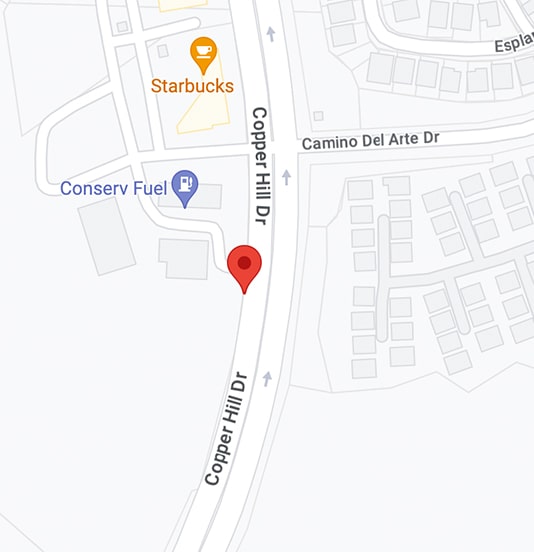Many factors affect a person's overall health, including dental and oral health. If a person has an issue with their jaw muscles or jaws, they will have difficulty speaking, chewing, or yawning. This usually indicates temporomandibular disorder (TMD), which occurs when the temporomandibular joint (TMJ) fails to function correctly. TMD is a dental issue that our experts at Valencia Advanced Dentistry at Copperhill Smiles can diagnose. If you are experiencing these or any other dental problems in Santa Clarita, get in touch with us for diagnosis and treatment.
An Overview of TMD and TMJ
People rely on their mouths for various essential functions that contribute to their survival and general health. Humans breathe, communicate verbally, and eat through their mouths. Jaw movement allows you to close and open your mouth. When this happens, a person can chew, speak, and yawn. Any issue with your jaws or their muscles can impair jaw function. This makes it difficult for a person to perform specific oral tasks.
The temporomandibular joint (TMJ) connects the upper and lower jaws, which enables you to close and open the mouth. This joint is situated at the base of the skull, just in front of your ears. It works similarly to door hinges, linking the maxilla and the mandible. TMJ enables the mandible (lower jaw) to move upward and downward, allowing the mouth to open and close normally. The joint also allows the mandible to move backward, forward, and sideways.
However, if your jaws are not functioning correctly, the oral cavity cannot perform some essential functions. This calls for an appointment with the dentist, who will prescribe various treatments, including at-home remedies and, in certain situations, surgery, to relieve the pain.
Causes of TMD
An issue with the joints that connect your jaw and skull implies that it has been damaged or injured. Medical professionals still need to understand what causes the damage or injury entirely. However, several factors have been identified as contributing to the stiffness of the muscles and dysfunction related to TMD.
However, whether any of these problems cause TMJ or result from a patient's symptoms is unclear. For example, injuries to the jaws or the muscles surrounding your neck and head could result from whiplash or a severe impact on the affected region.
Other possible causes of temporomandibular disorders are:
- Excessive chewing of gum.
- Stress and anxiety can cause a person to strain their jaws, teeth, and facial muscles, injuring the jaw muscles.
- Inflammation of the joints that hold the jaws together, arthritis, and other conditions caused by inflammation of the muscles that affect TMJ.
- Dislocation of soft tissues or discs between the joint socket and ball.
- Jaw or tooth trauma: this could lead to a dislocated or fractured jaw. A misaligned jaw can cause pain when you try to talk, yawn, chew, or open your mouth.
- Orthodontic braces.
Signs and Symptoms of Temporomandibular Disorders
TMD is most commonly diagnosed by experiencing pain in the jaw joint. The joint in question lies between the ears. In most cases, you can feel TMJ pain around the face, eyes, forehead, ears, or neck. The pain could be temporary or last for many years and can affect one or both sides of the face.
Other symptoms of TMD are:
- Tenderness or pain in the affected jaws. It could be noticeable around the affected joints.
- Crepitus refers to the clicking or popping sound made by the jaw. When one moves their joint, the sound becomes more noticeable. The sound is often muffled, and at other times, it is loud.
- Blurred vision.
- Experiencing pain that closely resembles a toothache, but it is not on the teeth.
- Some aches or crackling sounds in the ears.
- Tinnitus is a term used to describe ringing or popping noises in the ear. An individual would often feel fullness or pressure on their ears.
- Muscle tension and soreness around the jaws and neck.
- Recurring headaches and, on some occasions, migraines.
- Contraction of the affected jaw muscles.
- Tingling and numbness on the chin, as well as feeling soreness around the face, cheeks, jaw, or mouth.
- Pain felt on the surface of the tongue.
- Shoulder pain.
- A swelling, soreness, or lump on the temple area.
- Opening the mouth wide can be difficult at times.
- Lockjaw refers to the locking or dislocation of the jaw joint. It could be noticeable after yawning.
- Vertigo or dizziness.
- Difficulty yawning, speaking, chewing, or doing anything else that requires you to open your mouth.
- Exhaustion is reflected in your facial expression.
Pain While Receiving Dental Care
TMJ patients can find it challenging to perform basic oral hygiene. You may feel discomfort or pain while flossing, brushing, or cleaning your teeth regularly. Even if you are suffering from TMD, you can still maintain good dental hygiene by following these guidelines:
- Use a soft-bristled or sonic toothbrush to clean your teeth.
- Use an antiseptic mouthwash as part of your daily oral hygiene routine. The mouth rinse can cleanse your oral cavity of bacteria.
- If you cannot open your oral cavity due to pain, use water flossers or rubber tip stimulators to clean the teeth.
If you are constantly in pain during your dental treatment, you should consider taking pain relievers.
Schedule an appointment with your dentist and ask for advice on removing plaque without flossing. For instance, your dentist could suggest alternative dental hygiene techniques, like using cotton gauze to clean your teeth
Diagnosis Of Temporomandibular Disorder
It can be challenging to diagnose TMD immediately due to the wide range of symptoms mentioned earlier. Furthermore, different illnesses exhibit similar symptoms. Tooth decay, arthritis, and gum disease, for example, can cause pain, discomfort, swelling, and difficulty opening the mouth in the same way that TMD does. That is why it is crucial to consult a competent dentist to ensure your diagnosis is correct.
A professional dentist will examine your overall health before determining the problem with your jaws, teeth, or gums. They will also conduct a physical examination to ensure the recommended remedy suits your condition. The dentist will check your TMJs for pain and soreness during the physical examination.
They will also notice clicking, popping, or grating as you move your jaw joints. The dentist will examine the jaws to ensure they work correctly and do not lock when you close or open your mouth. Your dentist would also assess your biting and chewing habits to spot facial muscle issues.
For a more comprehensive view of your jaws, teeth, and TMJs, your dentist may recommend a full-mouth X-ray to check for any underlying problems. A dentist can also perform computer tomography and magnetic resonance imaging tests. When a person moves their jaws, an MRI can reveal whether the TMJ discs are appropriately positioned. A CT scan, on the other hand, can reveal the injured jaw joint's bone structure.
Once a problem is identified quickly, you will be sent to a dental surgeon for treatment and care. This surgeon specializes in procedures on the mouth, face, and jaw areas. You can also talk to an orthodontist, who will examine your teeth, muscles, and joints to ensure they function correctly.
Treatment For TMD
Independently performing activities can alleviate most of the TMD symptoms. Your dentist can also recommend some of the treatments listed above. Fortunately, most of the suggested home remedies are safe and can help the patient relieve stress and ease their tension. Modern therapies and at-home remedies can help manage the condition.
At-Home Remedies for TMJ Disorders
Using ice or cold packs on the area surrounding the injured joint is one of the most common treatments dentists recommend. Furthermore, no cost is involved, and the patient can complete it independently. Ice and cold packs help relieve pain and swelling. The patient can apply ice packs for no more than ten minutes.
Your dentist will also recommend that you take nonsteroidal anti-inflammatory drugs. Some of these medications include ibuprofen, naproxen, and pain relievers such as aspirin and acetaminophen, which can also help relieve swelling and pain.
Eating soft foods rather than hard foods and avoiding chewing gum may also be beneficial. Prolonged chewing and hard foods increase pressure on the affected joint, exacerbating the condition. Your dentist may recommend foods such as scrambled eggs. For now, you should avoid thick and large bites that require you to open your mouth wider.
Patients can benefit from self-stretching and gentle massage exercises for their jaw and neck muscles. Your dentist can recommend a physiotherapist or physician who can demonstrate some of the most effective stretches you can try at home to help with your condition. Start slowly when performing TMJ workouts. It's normal to experience pain and discomfort as you start your workouts. However, the pain is mild and could gradually fade.
You should consult your dentist if you experience severe discomfort or pain during TMJ exercises. Furthermore, you will only gain from the exercises if you perform TMJ workouts while your muscles relax. It is not clear how TMJ exercises help to relieve discomfort in the joints. However, these exercises help stretch and relax the muscles and enhance jaw mobility while decreasing jaw clicking.
Practicing relaxation techniques and managing stress can help to reduce teeth grinding and clenching. These are the leading causes of TMDs. A patient suffering from TMJ disorders can find short-term relief from their discomfort and pain by using soothing essential oils. Some examples include chamomile, sweet marjoram, lavender, and clary sage.
TMD Medical Treatment
There is no guarantee that home treatments will be effective. If they do not work for you, you can seek a medical solution to treat TMD and eliminate all the symptoms effectively. Some treatments are unlikely to treat temporomandibular disorder. However, they can offer temporary or lasting relief from pain and other issues.
Some examples include:
-
Dental Splints
A dental splint is used as a tooth protector. They are also called bite guards, occlusal splints, or stabilization splints. These oral appliances are designed to keep the teeth in their proper positions and stop you from grinding them. Many times, a jaw specialist will prescribe and fit dental splints.
-
Botox
A medical professional can prescribe Botox to help patients relax their jaw muscles.
-
Physiotherapy
This exercises the jaw muscles to improve their strength, flexibility, and range of motion.
-
Ultrasound
Deep heat is applied to the sore joints as part of this treatment to help them move better and ease the pain. A professional dentist can recommend trigger point injections to treat TMDs. Anesthesia is then injected into specific trigger points on your facial muscles. It helps to alleviate the discomfort and pain caused by TMD.
Patients with TMD could also benefit from other treatments like radiowave therapy. It involves stimulating the TMJs to increase blood flow. Improved flow of blood to the affected areas promotes pain alleviation. Your dentist can also propose low-level or mild laser treatments. This treatment is effective in reducing inflammation and pain. It also allows you to open your lips and move your neck easily.
-
Biobehavioral Management
Biobehavioral management, like biofeedback and cognitive behavioral therapy, can help alleviate TMJ discomfort.
-
Acupuncture
The trigger-point therapy with acupuncture can also help some patients with TMD.
-
Transcutaneous Electrical Nerve Stimulation (TENS)
A dentist can use TENS if none of the above medications are effective. They could administer low-level electrical currents to the affected region to relieve pain by relaxing the jaw and facial muscles. Patients could receive dental care at home or a dentist's office.
-
Medication in High Doses
When dealing with TMJ issues, a dentist can recommend using high doses of prescription medication, like NSAIDS, in addition to pain relievers and anti-inflammatory drugs. These drugs can help to reduce inflammation and pain while relaxing the jaw muscles. Stress sometimes causes TMD. Patients tend to grind and clench their teeth more when they are under stress or anxious.
As a first step, the dentist can suggest seeing a mental health expert, who could then prescribe medication to help with the patient's anxiety. Anti-anxiety medications can help to reduce stress, thus aiding in rehabilitation. Additionally, low-dose anti-anxiety medications can aid in pain relief.
-
Using Surgery to Treat TMDs
In its advanced form, TMD can be challenging to treat with medical and home remedies. As a result, a dentist can recommend surgery to resolve the problem permanently. The procedure cannot be undone once it has been carried out.
Thus, before moving further, you should consider your options and consult a qualified dentist. Patients suffering from TMD can have one of three forms of surgery based on the nature of their condition:
-
Arthrocentesis
A dentist can use this treatment if an individual has no significant history of TMJ disorders, yet their jaws are locked. The procedure is minor and can occur at a dentist's clinic or office. A general anesthetic will be administered to you before the procedure, and needles can be inserted into the affected joint to remove or unstick it.
-
Open-Joint Operation
This procedure is necessary when a dentist feels someone has lumps on or around the afflicted joint. It can also be used when the bone structures around the jaw joints erode. With the help of a general anesthetic, your dentist will carefully cut apart the area surrounding the affected joint to reach the underlying issue more effectively.
An open joint operation would take longer to heal. This surgical treatment carries a substantial risk of scarring and nerve injury.
-
Arthroscopy
This operation requires an arthroscope, a unique piece of equipment with a torch and a lens. The instrument allows dentists to check the jaw joints to determine the cause of your dental issue. Before the surgery begins, the patient receives anesthesia. The dental professional then creates a small cut to insert the arthroscope. This incision is made in the front part of the patient's ear.
Dentists then connect the device to a display monitor. It helps them evaluate the condition of the joints and surrounding locations. If the joints have inflammatory tissues, the oral surgeon will remove them and realign the joints or discs. This method is less intrusive, leaves only a minor scar, and carries fewer risks. You will recover rapidly following the operation. Usually, the recuperation period is much shorter than the original operation.
Are TMD and TMJ Different?
TMJ and TMD are often mistaken for each other. However, they represent different things. TMJ refers to the tiny, delicate joint in front of the ears that attaches the jaws to the skull. TMD refers to the joints and how irritation or inflammation affects them, which often causes discomfort or pain.
This disorder can cause headaches, facial pain, toothaches, and earaches. In simple terms, TMJ is the joint, whereas TMD involves a variety of conditions and dental problems that lead to severe pain and impair TMJ functionality.
Find a Santa Clarita Dental Clinic Near Me
Any problems with the jaws, teeth, gums, or mouth could make it impossible for the mouth to perform its functions. For instance, TMJ makes eating, speaking, and leading a quality life challenging. We at Valencia Advanced Dentistry at Copperhill Smiles have a team of dentists in Santa Clarita who can evaluate and recommend quality treatment for your TMD and other dental issues. Call us at 661-775-7717 and allow us to restore your beautiful smile.




